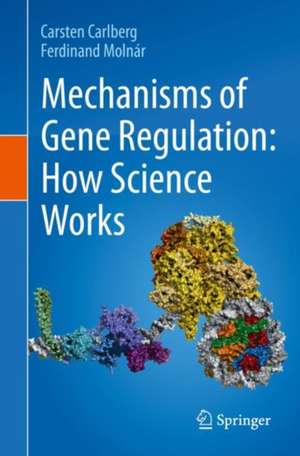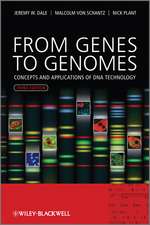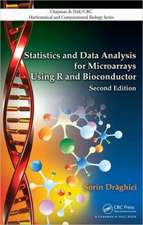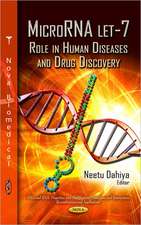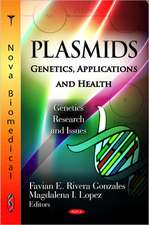Mechanisms of Gene Regulation: How Science Works
Autor Carsten Carlberg, Ferdinand Molnáren Limba Engleză Paperback – 30 oct 2020
| Toate formatele și edițiile | Preț | Express |
|---|---|---|
| Paperback (2) | 442.01 lei 38-44 zile | |
| SPRINGER NETHERLANDS – 7 iun 2018 | 442.01 lei 38-44 zile | |
| Springer International Publishing – 30 oct 2020 | 498.61 lei 38-44 zile | |
| Hardback (1) | 704.36 lei 3-5 săpt. | |
| SPRINGER NETHERLANDS – 16 iun 2016 | 704.36 lei 3-5 săpt. |
Preț: 498.61 lei
Preț vechi: 524.85 lei
-5% Nou
Puncte Express: 748
Preț estimativ în valută:
95.42€ • 99.25$ • 78.78£
95.42€ • 99.25$ • 78.78£
Carte tipărită la comandă
Livrare economică 08-14 aprilie
Preluare comenzi: 021 569.72.76
Specificații
ISBN-13: 9783030523206
ISBN-10: 3030523209
Pagini: 149
Ilustrații: XVI, 149 p. 71 illus., 70 illus. in color.
Dimensiuni: 155 x 235 x 9 mm
Greutate: 0.45 kg
Ediția:1st ed. 2020
Editura: Springer International Publishing
Colecția Springer
Locul publicării:Cham, Switzerland
ISBN-10: 3030523209
Pagini: 149
Ilustrații: XVI, 149 p. 71 illus., 70 illus. in color.
Dimensiuni: 155 x 235 x 9 mm
Greutate: 0.45 kg
Ediția:1st ed. 2020
Editura: Springer International Publishing
Colecția Springer
Locul publicării:Cham, Switzerland
Cuprins
Central dogma of molecular biology.- Impact of chromatin structure.- Epigenetics enables gene expression.- Gene regulation in the context of nuclear architecture.- Core promoter.- TATA box and other core promoter elements.- Genome-wide core promoter identification.- TFIID and Mediator as paradigms of multi-protein complexes.- Site-specific transcription factors and their domains.- Classification of transcription factors.- Activation of transcription factors.- Programing cellular differentiation by transcription factors.- Inflammatory signaling via NF-KB.- Sensing cellular stress via p53.- The nuclear receptor superfamily.- Molecular interactions of nuclear receptors.- Physiological role of nuclear receptors.- Next-generation sequencing.- Gene regulation in the context of Big Biology.- Exploring genome-wide transcription factor binding.- Integrating epigenome-wide datasets.- Cytosines and their methylation.- Histone modifications.- Gene regulation via chromatin modifiers.- Sensing energy metabolism via chromatin modifiers.- Epigenetics and chromatin.- Genome-wide understanding of epigenetics.- CTCF and genetic imprinting.- Epigenetics in health and disease.- Nucleosome positioning at promoters.- Chromatin remodeling.- Transcriptional dynamics in the presence of chromatin.- Organization of the nucleus.- Non-coding RNAs.- miRNAs and their regulatory potential.- Long ncRNAs.- Enhancer RNAs.
Notă biografică
Carsten Carlberg graduated 1989 with a PhD in biochemistry at the Free University Berlin (Germany). After positions as postdoc at Roche (Basel, Switzerland), group leader at the University of Geneva (Switzerland) and docent at the University of Düsseldorf (Germany) he is since 2000 full professor of biochemistry at the University of Eastern Finland in Kuopio (Finland). His work focuses on mechanisms of gene regulation by nuclear hormones, in particular on vitamin D. At present Prof. Carlberg focuses projects on epigenome-wide effects of vitamin D on the human immune system.
Ferdinand Molnár received his PhD in biochemistry from the University of Kuopio (Kuopio, Finland) in 2006. He did his postdoctoral training in Structural Biology at the IGBMC (Illkirch, France). In 2008 he joined the School of Pharmacy at the University of Eastern Finland (Kuopio, Finland) studying nuclear receptor-ligand, - protein and -DNA interactions. In 2018 he moved tothe Nazarbayev University (Nur-Sultan, Kazakhstan) where he holds an Associate Professor position at the Department of Biology. Prof. Molnár interests are integrative structural biology and bioinformatics, eukaryotic transcriptional regulation in health and disease and recombinant protein production.
Ferdinand Molnár received his PhD in biochemistry from the University of Kuopio (Kuopio, Finland) in 2006. He did his postdoctoral training in Structural Biology at the IGBMC (Illkirch, France). In 2008 he joined the School of Pharmacy at the University of Eastern Finland (Kuopio, Finland) studying nuclear receptor-ligand, - protein and -DNA interactions. In 2018 he moved tothe Nazarbayev University (Nur-Sultan, Kazakhstan) where he holds an Associate Professor position at the Department of Biology. Prof. Molnár interests are integrative structural biology and bioinformatics, eukaryotic transcriptional regulation in health and disease and recombinant protein production.
Caracteristici
Includes a high figure to text ratio to improve learning Based of 18 years teaching experience on the topic Provides in a condensed form an overview on the present understanding of the mechanisms of gene regulation
Textul de pe ultima copertă
This textbook aims to describe the fascinating area of eukaryotic gene regulation for graduate students in all areas of the biomedical sciences. Gene expression is essential in shaping the various phenotypes of cells and tissues and as such, regulation of gene expression is a fundamental aspect of nearly all processes in physiology, both in healthy and in diseased states. This pivotal role for the regulation of gene expression makes this textbook essential reading for students of all the biomedical sciences, in order to be better prepared for their specialized disciplines.
A complete understanding of transcription factors and the processes that alter their activity is a major goal of modern life science research. The availability of the whole human genome sequence (and that of other eukaryotic genomes) and the consequent development of next-generation sequencing technologies have significantly changed nearly all areas of the biological sciences. For example, the genome-wide location of histone modifications and transcription factor binding sites, such as provided by the ENCODE consortium, has greatly improved our understanding of gene regulation. Therefore, the focus of this book is the description of the post-genome understanding of gene regulation. The purpose of this book is to provide, in a condensed form, an overview on the present understanding of the mechanisms of gene regulation. The authors are not aiming to compete with comprehensive treatises, but rather focus on the essentials. Therefore, the authors have favored a high figure-to-text ratio following the rule stating that “a picture tells more than thousand words”.
The content of the book is based on the lecture course, which is given by Prof. Carlberg since 2001 at the University of Eastern Finland in Kuopio. The book is subdivided into 4 sections and 13 chapters. Following the Introduction there are three sections, which take a view on gene regulation from the perspective oftranscription factors, chromatin and non-coding RNA, respectively. Besides its value as a textbook, Mechanisms of Gene Regulation will be a useful reference for individuals working in biomedical laboratories.
A complete understanding of transcription factors and the processes that alter their activity is a major goal of modern life science research. The availability of the whole human genome sequence (and that of other eukaryotic genomes) and the consequent development of next-generation sequencing technologies have significantly changed nearly all areas of the biological sciences. For example, the genome-wide location of histone modifications and transcription factor binding sites, such as provided by the ENCODE consortium, has greatly improved our understanding of gene regulation. Therefore, the focus of this book is the description of the post-genome understanding of gene regulation. The purpose of this book is to provide, in a condensed form, an overview on the present understanding of the mechanisms of gene regulation. The authors are not aiming to compete with comprehensive treatises, but rather focus on the essentials. Therefore, the authors have favored a high figure-to-text ratio following the rule stating that “a picture tells more than thousand words”.
The content of the book is based on the lecture course, which is given by Prof. Carlberg since 2001 at the University of Eastern Finland in Kuopio. The book is subdivided into 4 sections and 13 chapters. Following the Introduction there are three sections, which take a view on gene regulation from the perspective oftranscription factors, chromatin and non-coding RNA, respectively. Besides its value as a textbook, Mechanisms of Gene Regulation will be a useful reference for individuals working in biomedical laboratories.
